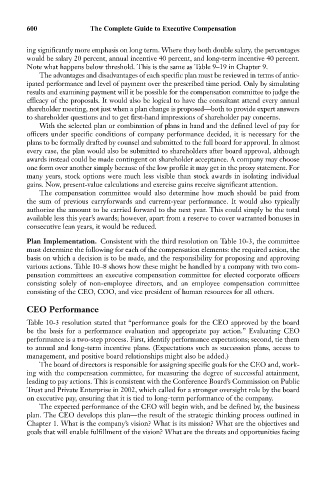Page 614 - Bruce Ellig - The Complete Guide to Executive Compensation (2007)
P. 614
600 The Complete Guide to Executive Compensation
ing significantly more emphasis on long term. Where they both double salary, the percentages
would be salary 20 percent, annual incentive 40 percent, and long-term incentive 40 percent.
Note what happens below threshold. This is the same as Table 9–19 in Chapter 9.
The advantages and disadvantages of each specific plan must be reviewed in terms of antic-
ipated performance and level of payment over the prescribed time period. Only by simulating
results and examining payment will it be possible for the compensation committee to judge the
efficacy of the proposals. It would also be logical to have the consultant attend every annual
shareholder meeting, not just when a plan change is proposed—both to provide expert answers
to shareholder questions and to get first-hand impressions of shareholder pay concerns.
With the selected plan or combination of plans in hand and the defined level of pay for
officers under specific conditions of company performance decided, it is necessary for the
plans to be formally drafted by counsel and submitted to the full board for approval. In almost
every case, the plan would also be submitted to shareholders after board approval, although
awards instead could be made contingent on shareholder acceptance. A company may choose
one form over another simply because of the low profile it may get in the proxy statement. For
many years, stock options were much less visible than stock awards in isolating individual
gains. Now, present-value calculations and exercise gains receive significant attention.
The compensation committee would also determine how much should be paid from
the sum of previous carryforwards and current-year performance. It would also typically
authorize the amount to be carried forward to the next year. This could simply be the total
available less this year’s awards; however, apart from a reserve to cover warranted bonuses in
consecutive lean years, it would be reduced.
Plan Implementation. Consistent with the third resolution on Table 10-3, the committee
must determine the following for each of the compensation elements: the required action, the
basis on which a decision is to be made, and the responsibility for proposing and approving
various actions. Table 10–8 shows how these might be handled by a company with two com-
pensation committees: an executive compensation committee for elected corporate officers
consisting solely of non-employee directors, and an employee compensation committee
consisting of the CEO, COO, and vice president of human resources for all others.
CEO Performance
Table 10-3 resolution stated that “performance goals for the CEO approved by the board
be the basis for a performance evaluation and appropriate pay action.” Evaluating CEO
performance is a two-step process. First, identify performance expectations; second, tie them
to annual and long-term incentive plans. (Expectations such as succession plans, access to
management, and positive board relationships might also be added.)
The board of directors is responsible for assigning specific goals for the CEO and, work-
ing with the compensation committee, for measuring the degree of successful attainment,
leading to pay actions. This is consistent with the Conference Board’s Commission on Public
Trust and Private Enterprise in 2002, which called for a stronger oversight role by the board
on executive pay, ensuring that it is tied to long-term performance of the company.
The expected performance of the CEO will begin with, and be defined by, the business
plan. The CEO develops this plan—the result of the strategic thinking process outlined in
Chapter 1. What is the company’s vision? What is its mission? What are the objectives and
goals that will enable fulfillment of the vision? What are the threats and opportunities facing

